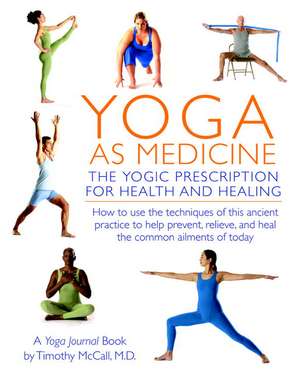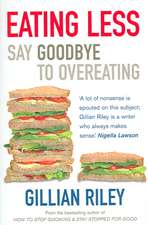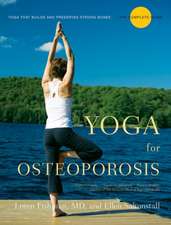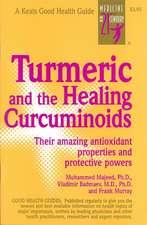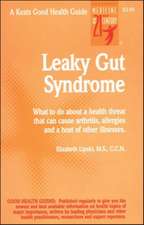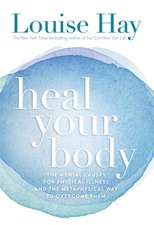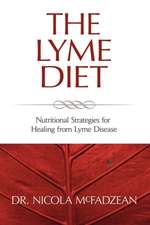Yoga as Medicine
Autor Timothy B. McCallen Limba Engleză Paperback – 18 oct 2012
Beginning with an overview of the history and science of yoga, Dr. McCall describes the many different techniques in the yoga tool kit; explains what yoga does and who can benefit from it (virtually everyone!); and provides lavishly illustrated and minutely detailed instructions on starting a yoga practice geared to your fitness level and your health status. Yoga as Medicine offers a wealth of practical information, including how to:
•Utilize yogic tools, including postures, breathing techniques, and meditation, for both prevention and healing of illness
•Master the art of becoming more in tune with your body
•Communicate more effectively with your doctor
•Adopt therapeutic yoga practices as either an alternative or a complement to surgery and to expensive, sometimes dangerous medications
•Practice safely
Find an instructor and a style of yoga that are right for you. With twenty chapters devoted to the work of individual master teachers, including such well-known figures as Patricia Walden, John Friend, and Rodney Yee, Yoga as Medicine shows how these experts have applied the wisdom of this ancient holistic practice to twenty different conditions, ranging from arthritis to chronic fatigue, depression, heart disease, HIV/AIDS, infertility, insomnia, multiple sclerosis, and obesity. Defining yoga as “a systematic technology to improve the body, understand the mind, and free the spirit,“ Dr. McCall shows the way to a path that can truly alter your life.
An indispensable guide for the millions who now practice yoga or would like to begin, as well as for yoga teachers, body workers, doctors, nurses, and other health professionals.
Preț: 122.49 lei
Preț vechi: 139.50 lei
-12% Nou
Puncte Express: 184
Preț estimativ în valută:
23.44€ • 24.47$ • 19.40£
23.44€ • 24.47$ • 19.40£
Carte disponibilă
Livrare economică 15-22 martie
Livrare express 01-07 martie pentru 68.11 lei
Preluare comenzi: 021 569.72.76
Specificații
ISBN-13: 9780553384062
ISBN-10: 0553384066
Pagini: 568
Ilustrații: 350 Black and White Photographs
Dimensiuni: 187 x 231 x 31 mm
Greutate: 1 kg
Editura: Bantam Books
ISBN-10: 0553384066
Pagini: 568
Ilustrații: 350 Black and White Photographs
Dimensiuni: 187 x 231 x 31 mm
Greutate: 1 kg
Editura: Bantam Books
Recenzii
"Yoga as Medicine is a powerfully clear, accessible and practical guide to creating a vibrantly healthy body, mind, and spirit. What a tremendous contribution to healing and human potential!"—Joan Borysenko, PhD, author of Minding the Body, Mending the Mind
“Read this to find out why we teach our patients YOGA.”—Mehmet Oz, MD, author of YOU: The Owner’s Manual and Professor and Vice Chairman, NY Presbyterian/ Columbia University Hospital
“Self-administered yoga therapy, taking your cues from a book or magazine, can be a tricky, even risky business. But Yoga as Medicine is the next best thing to having the doctor right there beside you. An instant classic.”—Richard Rosen, Contributing Editor, Yoga Journal and Director, Piedmont Yoga Studio
“Yoga as Medicine is beautifully organized and presented, making it instantly readable and practical for anyone desiring better health or immediate help with a particular problem.”—Christiane Northrup, MD, author of Mother-Daughter Wisdom, The Wisdom of Menopause, and Women’s Bodies, Women’s Wisdom
“Read this to find out why we teach our patients YOGA.”—Mehmet Oz, MD, author of YOU: The Owner’s Manual and Professor and Vice Chairman, NY Presbyterian/ Columbia University Hospital
“Self-administered yoga therapy, taking your cues from a book or magazine, can be a tricky, even risky business. But Yoga as Medicine is the next best thing to having the doctor right there beside you. An instant classic.”—Richard Rosen, Contributing Editor, Yoga Journal and Director, Piedmont Yoga Studio
“Yoga as Medicine is beautifully organized and presented, making it instantly readable and practical for anyone desiring better health or immediate help with a particular problem.”—Christiane Northrup, MD, author of Mother-Daughter Wisdom, The Wisdom of Menopause, and Women’s Bodies, Women’s Wisdom
Notă biografică
Timothy McCall, M.D., is a specialist in primary care who lives in the San Francisco Bay Area. As a board-certified, Western-trained physician who has traveled to India and throughout the United States observing, training with, and interviewing the world’s leading yoga teachers and therapists, he is uniquely qualified to reconcile the medical findings and techniques of East and West. Yoga Journal is the premier yoga magazine in the country.
Extras
Introduction
In this book, i’m asking you to think of yoga as medicine–a concept which is perhaps new and quite foreign to you. Because it is a kind of medicine that can benefit the healthy as well as the sick, I’m going to suggest that you consider starting a regular practice, no matter what your current state of health. You may have seen pictures of yoga contortionists or heard about grueling “power yoga” and “hot yoga” classes that convinced you this isn’t something you could possibly do. If so, I hope to show you that virtually anyone can do yoga, including those who start out with little strength, energy, or flexibility, and those who are ill or injured.
I say this not as a lifelong yoga teacher or someone who can readily bend his body into the shape of a square knot–I’m not, not by a long shot. I am a physician, a board-certified specialist in internal medicine, who came to yoga in middle age and found it–and continues to find it–incredibly challenging. But in this challenge, I have seen steady growth in what I can do and how good I feel. My body has changed in ways I wouldn’t have believedpossible, as has my mental state. The more I put into my yoga practice, the greater the rewards have become.
I signed up for my first yoga class in the same spirit that I’d brought to salsa dancing and tai chi. It was simply something interesting I’d heard about and decided to try. I didn’t come in with any kind of faith that yoga would change my life, but it did. At first my progress was slow. I studied yoga casually for a couple of years, making it to a class every other week or so. Due to my busy schedule, I never seemed to find the time to practice at home, even though my teacher, Patricia Walden, had said many times that fifteen or twenty minutes every day was much more valuable than a longer session once a week.
Like a lot of people who play competitive sports and never pay much attention to stretching, I’d started out incredibly stiff. I had great difficulty with even the most basic poses. With my legs straight, I couldn’t touch the floor with my fingertips. I couldn’t sit cross-legged without feeling discomfort in my upper back. I had difficulty just straightening my spine, let alone bending it backward. And even though I enjoyed the feeling of peace that class left me with those first two years, my body never became much more flexible. Then I made a decision: I was going to take a leap of faith.
I resolved to get up every morning for one year and practice yoga. I bought a mat, a strap, and a book describing the basic stretching, strengthening, and relaxation poses known as asana (pronounced AH-sah-nah). Even if my schedule was crazy and I could only fit in a few minutes, I’d do it. I started inserting yoga into the cracks in my day. If I was sitting at the computer or had a break between patients, I’d take a minute to stretch my arms over my head or bend forward, place my hands on the desk, and lengthen my spine for a few seconds. If I was on the road, I’d do asanas in my hotel room. I started to pay more attention to my body, noticing the way my shoulders tended to slump as I sat behind the wheel or read a book.
With regular practice, amazing things began to happen. After a few months, my chest started to open up. My friends and family noticed that my chronically slouching posture, from years of studying and computer work, was improving. The knots that I had thought were a permanent fixture in my upper back slowly melted away. I didn’t get injured as often as I used to. In the five years before starting yoga, I gave up basketball due to heel spurs and I lost a year of playing tennis due to an inflammation of my elbow. I’d noticed the twinges of pain that heralded a rotator cuff problem in my shoulder. Chronic pain in my Achilles tendon had me worried that I’d suffer the same kind of rupture I’d seen my
best friend go through. All of these problems are better now, and I suspect that if I’d been doing yoga all along, I might have avoided many of them completely.
Perhaps even more profound than yoga’s physical effect on me were the mental and psychological benefits. Once I developed a regular practice, I noticed a change in outlook. Problems didn’t seem to get to me as much. If I dropped a tray of ice cubes and they scattered across the kitchen floor, I didn’t blurt out words that would get beeped off network TV. I just laughed, shook my head, and cleaned up. I didn’t seem to worry as much. Without even consciously trying, more and more I seemed to be doing what yoga philosophy teaches: to give your best effort without being attached to the result.
Yoga also had an even deeper effect on me. A couple of years after starting yoga, I decided to leave direct patient care and devote myself full-time to research and writing. With the rise of the managed-care approach to medicine, I found it increasingly stressful as well as difficult to do what I thought was right for my patients. As the conveyor belt of care was sped up to cut costs, I wasn’t getting the chance to know patients as well as I wanted to, which greatly diminished one of the most satisfying aspects of doctoring. It’s not quite true to say that yoga led me to quit my medical practice, but yoga did put me in touch with an inner voice that was telling me, This isn’t working anymore.
It was ten years ago that I took that leap of faith. Since then I’ve continued to do yoga poses virtually every day and I’ve added breathing exercises known as pranayama (prahnai-YAH-mah), meditation, and other practices to my routine. My body has continued to change. I’ve gained muscle, lost fat, and become a lot more flexible. When I’m warmed up, I can stand with my legs straight and place my palms flat on the floor. I can do some poses that I used to think would never be possible, though there are still plenty of them– including backbends–that I have great difficulty with. But these markers of physical prowess aren’t what really counts.
What’s become more important to me is the mental peace that has come, the sense of gratitude, the gradual and sometimes sudden opening of some formerly inflexible area of my body or mind, and the feeling of community I’ve found with fellow students and teachers. Stepping out of the crazy, fast-paced world to pay close attention to what’s happening right then and there puts me in touch with a calm place deep inside me–deep inside all of us. It’s like the stillness on the ocean floor that remains undisturbed, no matter how frantically waves crash on the surface.
For the last several years, in addition to deepening my own yoga practice, I’ve been investigating the use of yoga for people suffering from a variety of medical conditions. My interest was originally sparked by all the stories I heard from people who said yoga had helped them deal with depression or back pain or a difficult transition into menopause.
The process of learning about yoga therapy, however, hasn’t been easy. For starters, there is no one place to acquire this knowledge; the yoga world is incredibly Balkanized. There are dozens of competing traditions, many of which don’t seem interested in sharing their discoveries with each other or the outside world. Complicating matters further, some of what I’ve heard from yoga teachers, or read in magazines, quite frankly defies modern understanding of anatomy and physiology, or is grounded in a metaphysics that can be off-putting or virtually incomprehensible. In addition, many yoga teachers with
much to offer are shy about touting yoga’s therapeutic potential–especially in writing–while others who in my estimation have far less substance boldly claim their brand of yoga can cure any disease.
Not to be deterred, I’ve read books, attended classes, workshops, and conferences, reviewed the scientific literature, and sought out some of the world’s leading yoga teachers and yoga therapists to find out what they’re doing and what they find most helpful. You’ll hear from many of these teachers in this book. I’ve also worked with my teacher, Patricia Walden, using yoga to treat people with such maladies as depression, breast cancer, and Parkinson’s disease. Although we didn’t do rigorous scientific studies, my strong impression based on years of clinical medical experience is that these students benefited enormously.
Patricia teaches a style of yoga known as the Iyengar method, named after the aging master B. K. S. Iyengar, and that’s the style we used in the therapeutic work we’ve done together. In my role as a writer and scientist interested in researching this field, however, I have taken workshops, had private therapy sessions, and learned from teachers in dozens of different styles. One of the most amazing things I have observed is that every system of therapeutic yoga I’ve looked at seems to help people heal.
Reflecting the multitude of good choices in therapeutic yoga, this book takes a pragmatic approach. It features yoga teachers from many different traditions using a broad range of approaches and tools. Every one of these yoga therapists brings decades of experience to the task.
Not all yoga styles are represented in this book. There are more approaches and teachers out there than it’s possible to research or include. Some omissions are deliberate because I do not believe that all systems of yoga, particularly those that are more physically demanding, are appropriate for people with serious disease. (This is not to criticize these styles of yoga for people who are fit and healthy. Many people love them and they have their place.)
Because this book is aimed at a Western audience and because I am a doctor, I use the language and perspective of science as much as possible. I know this is the best way to show physicians and other health care professionals that yoga as medicine could benefit their patients–including many who don’t respond well to conventional therapies, who may be among the most frustrating of their patients to treat.
Most conventional doctors have almost no knowledge of the potential medical applications of yoga. But it isn’t really their fault. I don’t recall hearing a single word about yoga in medical school, in three years of postgraduate training in internal medicine, or in the dozens of seminars and conferences I attended in more than ten years of office-based medical practice. Looking back, it makes me sad to think of all the patients I saw before I discovered yoga who might have benefitted from it–many of whom didn’t find any relief in what was available.
Although there are more than a hundred scientific studies that have found yoga to be an effective treatment for a variety of medical problems, from heart disease to carpal tunnel syndrome, most of this work is unknown to the average physician. While a few of these studies, mostly those done in the West, have gotten media attention here, the overwhelming majority of the scientific research into yoga takes place in India. Most of this Indian research is difficult or impossible to get access to in this country, which is part of the reason most physicians and most yogis have never heard of it. To learn more, in 2002 I spent more than two months traveling to different yoga therapy clinics and research institutions in India. I’ll be sharing some of my discoveries from that trip with you in this book. Since then I have returned twice to continue my research, focusing in particular on the connections between therapeutic yoga and the ancient system of Indian medicine, Ayurveda, which I’ll also discuss.
But no review of research, or visits to clinics or studios of master practitioners is sufficient to understand yoga. To really grasp what yoga can do, you need to experience it yourself. That’s why I’m urging you to consider taking a leap of faith, like the one I took ten years ago. It was my experience that made me believe in yoga; not any preconceptions. My experience tells me yoga works–in addition, of course, to the scientific evidence and what I’ve directly observed and heard from others.
My suggestion is to suspend disbelief just long enough to try a few sessions of yoga and let your experience dictate whether to continue. If you find yoga brings you nothing, you won’t have lost much. But if you find the experience as eye-opening as I have, you have a whole world to gain.
Yoga is something you learn by doing. I’ve been practicing for about twelve years, but there are people who have been at it decades longer who greatly surpass me in yoga expertise. Nonetheless, I believe that as a medical doctor as well as a serious student of yoga, I can offer a helpful perspective to people hoping to heal, people doing healing work with others, and anyone who’s just curious about yoga’s health benefits–unlike Western medicine, yoga can help the healthy as well as the sick to feel better.
If science is the modern world’s greatest contribution to knowledge, then yoga is the gem of the ancient world. It is my belief that these two ways of knowing–which seem so different, even at odds with each other–can be reconciled, advancing our understanding more than either discipline alone. Combining the insights of these two great systems can result in an increase in the likelihood of better health, a reduction in bothersome symptoms, and the relief of suffering.
Yoga is not a panacea, but it is powerful medicine indeed for body, mind, and spirit. Above all, yoga is a path. The longer you stay with it and the more heart you put into the journey, the farther it can take you.
In this book, i’m asking you to think of yoga as medicine–a concept which is perhaps new and quite foreign to you. Because it is a kind of medicine that can benefit the healthy as well as the sick, I’m going to suggest that you consider starting a regular practice, no matter what your current state of health. You may have seen pictures of yoga contortionists or heard about grueling “power yoga” and “hot yoga” classes that convinced you this isn’t something you could possibly do. If so, I hope to show you that virtually anyone can do yoga, including those who start out with little strength, energy, or flexibility, and those who are ill or injured.
I say this not as a lifelong yoga teacher or someone who can readily bend his body into the shape of a square knot–I’m not, not by a long shot. I am a physician, a board-certified specialist in internal medicine, who came to yoga in middle age and found it–and continues to find it–incredibly challenging. But in this challenge, I have seen steady growth in what I can do and how good I feel. My body has changed in ways I wouldn’t have believedpossible, as has my mental state. The more I put into my yoga practice, the greater the rewards have become.
I signed up for my first yoga class in the same spirit that I’d brought to salsa dancing and tai chi. It was simply something interesting I’d heard about and decided to try. I didn’t come in with any kind of faith that yoga would change my life, but it did. At first my progress was slow. I studied yoga casually for a couple of years, making it to a class every other week or so. Due to my busy schedule, I never seemed to find the time to practice at home, even though my teacher, Patricia Walden, had said many times that fifteen or twenty minutes every day was much more valuable than a longer session once a week.
Like a lot of people who play competitive sports and never pay much attention to stretching, I’d started out incredibly stiff. I had great difficulty with even the most basic poses. With my legs straight, I couldn’t touch the floor with my fingertips. I couldn’t sit cross-legged without feeling discomfort in my upper back. I had difficulty just straightening my spine, let alone bending it backward. And even though I enjoyed the feeling of peace that class left me with those first two years, my body never became much more flexible. Then I made a decision: I was going to take a leap of faith.
I resolved to get up every morning for one year and practice yoga. I bought a mat, a strap, and a book describing the basic stretching, strengthening, and relaxation poses known as asana (pronounced AH-sah-nah). Even if my schedule was crazy and I could only fit in a few minutes, I’d do it. I started inserting yoga into the cracks in my day. If I was sitting at the computer or had a break between patients, I’d take a minute to stretch my arms over my head or bend forward, place my hands on the desk, and lengthen my spine for a few seconds. If I was on the road, I’d do asanas in my hotel room. I started to pay more attention to my body, noticing the way my shoulders tended to slump as I sat behind the wheel or read a book.
With regular practice, amazing things began to happen. After a few months, my chest started to open up. My friends and family noticed that my chronically slouching posture, from years of studying and computer work, was improving. The knots that I had thought were a permanent fixture in my upper back slowly melted away. I didn’t get injured as often as I used to. In the five years before starting yoga, I gave up basketball due to heel spurs and I lost a year of playing tennis due to an inflammation of my elbow. I’d noticed the twinges of pain that heralded a rotator cuff problem in my shoulder. Chronic pain in my Achilles tendon had me worried that I’d suffer the same kind of rupture I’d seen my
best friend go through. All of these problems are better now, and I suspect that if I’d been doing yoga all along, I might have avoided many of them completely.
Perhaps even more profound than yoga’s physical effect on me were the mental and psychological benefits. Once I developed a regular practice, I noticed a change in outlook. Problems didn’t seem to get to me as much. If I dropped a tray of ice cubes and they scattered across the kitchen floor, I didn’t blurt out words that would get beeped off network TV. I just laughed, shook my head, and cleaned up. I didn’t seem to worry as much. Without even consciously trying, more and more I seemed to be doing what yoga philosophy teaches: to give your best effort without being attached to the result.
Yoga also had an even deeper effect on me. A couple of years after starting yoga, I decided to leave direct patient care and devote myself full-time to research and writing. With the rise of the managed-care approach to medicine, I found it increasingly stressful as well as difficult to do what I thought was right for my patients. As the conveyor belt of care was sped up to cut costs, I wasn’t getting the chance to know patients as well as I wanted to, which greatly diminished one of the most satisfying aspects of doctoring. It’s not quite true to say that yoga led me to quit my medical practice, but yoga did put me in touch with an inner voice that was telling me, This isn’t working anymore.
It was ten years ago that I took that leap of faith. Since then I’ve continued to do yoga poses virtually every day and I’ve added breathing exercises known as pranayama (prahnai-YAH-mah), meditation, and other practices to my routine. My body has continued to change. I’ve gained muscle, lost fat, and become a lot more flexible. When I’m warmed up, I can stand with my legs straight and place my palms flat on the floor. I can do some poses that I used to think would never be possible, though there are still plenty of them– including backbends–that I have great difficulty with. But these markers of physical prowess aren’t what really counts.
What’s become more important to me is the mental peace that has come, the sense of gratitude, the gradual and sometimes sudden opening of some formerly inflexible area of my body or mind, and the feeling of community I’ve found with fellow students and teachers. Stepping out of the crazy, fast-paced world to pay close attention to what’s happening right then and there puts me in touch with a calm place deep inside me–deep inside all of us. It’s like the stillness on the ocean floor that remains undisturbed, no matter how frantically waves crash on the surface.
For the last several years, in addition to deepening my own yoga practice, I’ve been investigating the use of yoga for people suffering from a variety of medical conditions. My interest was originally sparked by all the stories I heard from people who said yoga had helped them deal with depression or back pain or a difficult transition into menopause.
The process of learning about yoga therapy, however, hasn’t been easy. For starters, there is no one place to acquire this knowledge; the yoga world is incredibly Balkanized. There are dozens of competing traditions, many of which don’t seem interested in sharing their discoveries with each other or the outside world. Complicating matters further, some of what I’ve heard from yoga teachers, or read in magazines, quite frankly defies modern understanding of anatomy and physiology, or is grounded in a metaphysics that can be off-putting or virtually incomprehensible. In addition, many yoga teachers with
much to offer are shy about touting yoga’s therapeutic potential–especially in writing–while others who in my estimation have far less substance boldly claim their brand of yoga can cure any disease.
Not to be deterred, I’ve read books, attended classes, workshops, and conferences, reviewed the scientific literature, and sought out some of the world’s leading yoga teachers and yoga therapists to find out what they’re doing and what they find most helpful. You’ll hear from many of these teachers in this book. I’ve also worked with my teacher, Patricia Walden, using yoga to treat people with such maladies as depression, breast cancer, and Parkinson’s disease. Although we didn’t do rigorous scientific studies, my strong impression based on years of clinical medical experience is that these students benefited enormously.
Patricia teaches a style of yoga known as the Iyengar method, named after the aging master B. K. S. Iyengar, and that’s the style we used in the therapeutic work we’ve done together. In my role as a writer and scientist interested in researching this field, however, I have taken workshops, had private therapy sessions, and learned from teachers in dozens of different styles. One of the most amazing things I have observed is that every system of therapeutic yoga I’ve looked at seems to help people heal.
Reflecting the multitude of good choices in therapeutic yoga, this book takes a pragmatic approach. It features yoga teachers from many different traditions using a broad range of approaches and tools. Every one of these yoga therapists brings decades of experience to the task.
Not all yoga styles are represented in this book. There are more approaches and teachers out there than it’s possible to research or include. Some omissions are deliberate because I do not believe that all systems of yoga, particularly those that are more physically demanding, are appropriate for people with serious disease. (This is not to criticize these styles of yoga for people who are fit and healthy. Many people love them and they have their place.)
Because this book is aimed at a Western audience and because I am a doctor, I use the language and perspective of science as much as possible. I know this is the best way to show physicians and other health care professionals that yoga as medicine could benefit their patients–including many who don’t respond well to conventional therapies, who may be among the most frustrating of their patients to treat.
Most conventional doctors have almost no knowledge of the potential medical applications of yoga. But it isn’t really their fault. I don’t recall hearing a single word about yoga in medical school, in three years of postgraduate training in internal medicine, or in the dozens of seminars and conferences I attended in more than ten years of office-based medical practice. Looking back, it makes me sad to think of all the patients I saw before I discovered yoga who might have benefitted from it–many of whom didn’t find any relief in what was available.
Although there are more than a hundred scientific studies that have found yoga to be an effective treatment for a variety of medical problems, from heart disease to carpal tunnel syndrome, most of this work is unknown to the average physician. While a few of these studies, mostly those done in the West, have gotten media attention here, the overwhelming majority of the scientific research into yoga takes place in India. Most of this Indian research is difficult or impossible to get access to in this country, which is part of the reason most physicians and most yogis have never heard of it. To learn more, in 2002 I spent more than two months traveling to different yoga therapy clinics and research institutions in India. I’ll be sharing some of my discoveries from that trip with you in this book. Since then I have returned twice to continue my research, focusing in particular on the connections between therapeutic yoga and the ancient system of Indian medicine, Ayurveda, which I’ll also discuss.
But no review of research, or visits to clinics or studios of master practitioners is sufficient to understand yoga. To really grasp what yoga can do, you need to experience it yourself. That’s why I’m urging you to consider taking a leap of faith, like the one I took ten years ago. It was my experience that made me believe in yoga; not any preconceptions. My experience tells me yoga works–in addition, of course, to the scientific evidence and what I’ve directly observed and heard from others.
My suggestion is to suspend disbelief just long enough to try a few sessions of yoga and let your experience dictate whether to continue. If you find yoga brings you nothing, you won’t have lost much. But if you find the experience as eye-opening as I have, you have a whole world to gain.
Yoga is something you learn by doing. I’ve been practicing for about twelve years, but there are people who have been at it decades longer who greatly surpass me in yoga expertise. Nonetheless, I believe that as a medical doctor as well as a serious student of yoga, I can offer a helpful perspective to people hoping to heal, people doing healing work with others, and anyone who’s just curious about yoga’s health benefits–unlike Western medicine, yoga can help the healthy as well as the sick to feel better.
If science is the modern world’s greatest contribution to knowledge, then yoga is the gem of the ancient world. It is my belief that these two ways of knowing–which seem so different, even at odds with each other–can be reconciled, advancing our understanding more than either discipline alone. Combining the insights of these two great systems can result in an increase in the likelihood of better health, a reduction in bothersome symptoms, and the relief of suffering.
Yoga is not a panacea, but it is powerful medicine indeed for body, mind, and spirit. Above all, yoga is a path. The longer you stay with it and the more heart you put into the journey, the farther it can take you.
Descriere
The most respected yoga publication in North America presents this comprehensive and accessibly organized guide. "Yoga Journal" along with Dr. McCall bring the findings and teachings of yoga together with Western medical science in a book practitioners of yoga will embrace.
